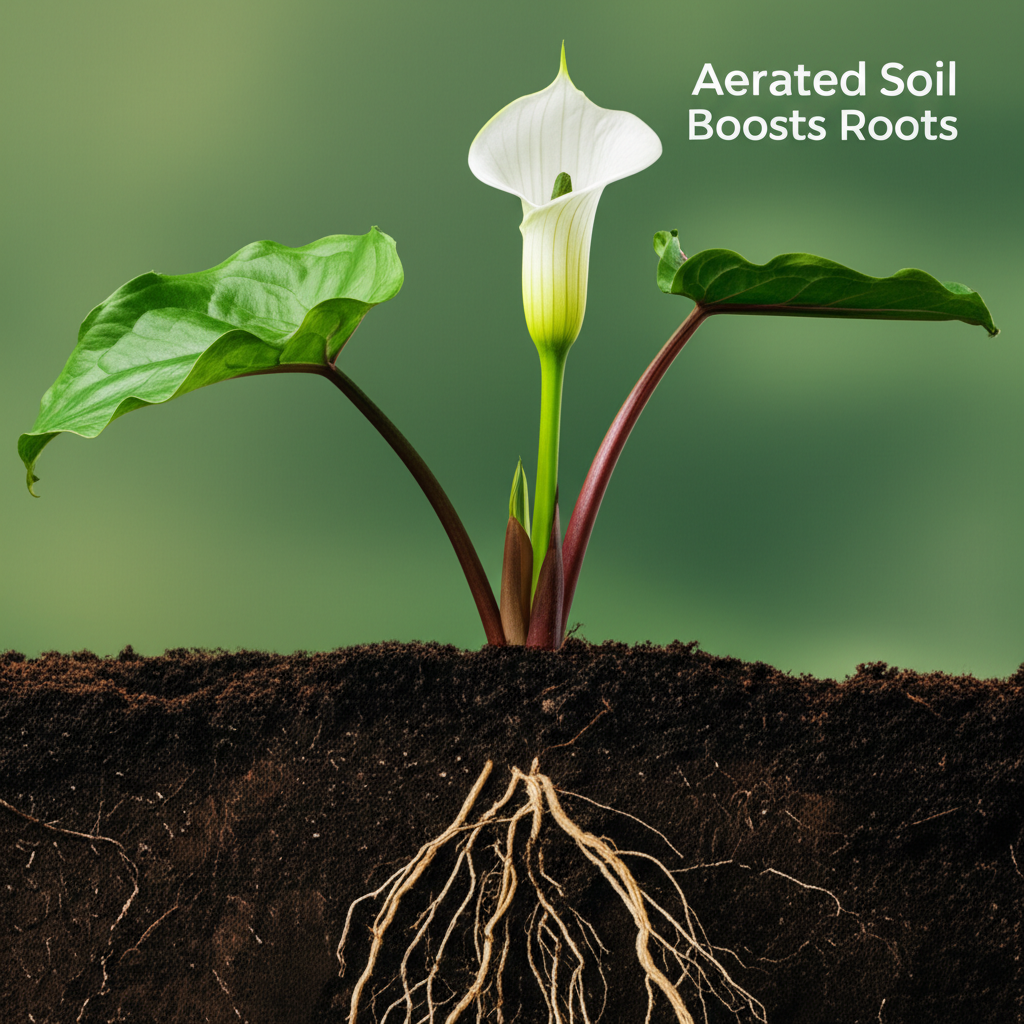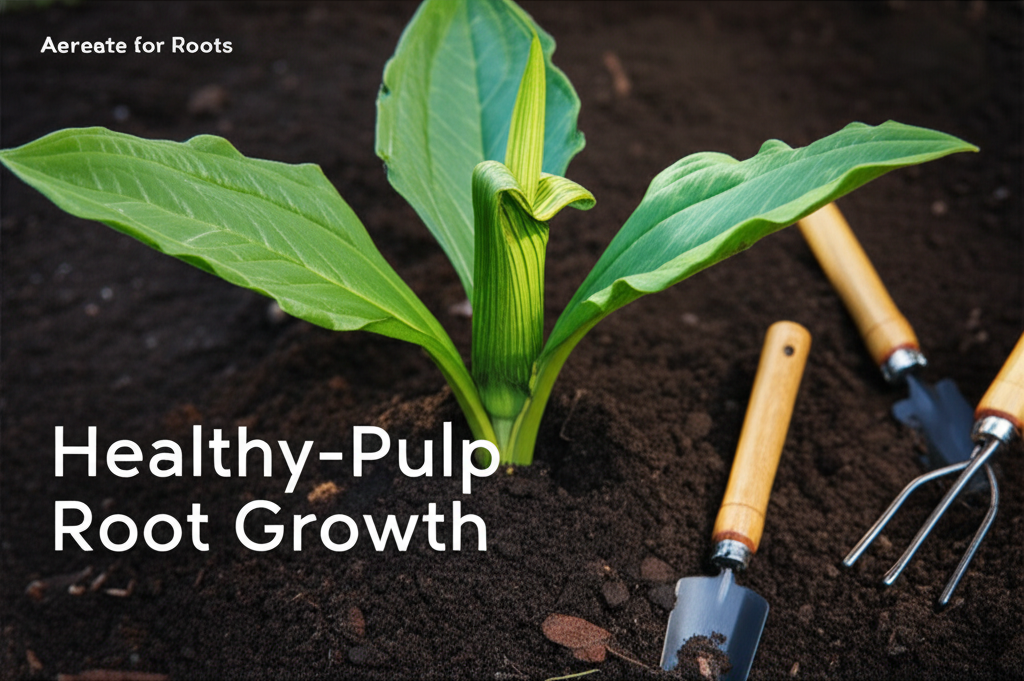The Foundation of a Flourishing Jack-in-the-Pulpit: Why Soil Aeration is Paramount
The enchanting Jack-in-the-Pulpit (Arisaema triphyllum) is a captivating native woodland perennial, instantly recognizable by its unique spathe and spadix. While its distinctive bloom captures attention, the true secret to its vigor and longevity lies beneath the surface, within its root system. Just as essential as sunlight and water, soil aeration plays a critical, yet often overlooked, role in ensuring these woodland wonders thrive. This article delves deep into the science and practice of optimizing soil aeration for Jack-in-the-Pulpit, empowering gardeners and plant enthusiasts to cultivate healthier, more resilient plants.
Understanding Soil Aeration: More Than Just Air
Soil aeration refers to the presence and movement of gases, primarily oxygen and carbon dioxide, within the soil. These gases are vital for the biological processes occurring in the soil, most importantly for the respiration of plant roots and beneficial soil microorganisms. Compacted soil, characterized by a lack of pore space, restricts this gas exchange, leading to a cascade of detrimental effects on plant health. For Jack-in-the-Pulpit, which hails from moist, but well-drained woodland environments, optimal aeration is not merely beneficial; it is a fundamental requirement for survival and prosperity.
The Root of the Matter: How Aeration Impacts Root Growth
Plant roots are living organisms that require oxygen for cellular respiration. This process generates the energy necessary for roots to absorb water and nutrients, anchor the plant, and grow. When soil is compacted and lacks oxygen, roots are essentially suffocating. This leads to:
- Stunted Growth: Inadequate oxygen inhibits root elongation and branching, resulting in a smaller, less effective root system.
- Reduced Nutrient Uptake: Roots cannot efficiently absorb essential minerals and nutrients without sufficient energy from respiration.
- Increased Susceptibility to Disease: Weakened roots are more vulnerable to soil-borne pathogens and fungal infections.
- Waterlogging and Root Rot: While Jack-in-the-Pulpit appreciates moisture, waterlogged soil with poor aeration can lead to anaerobic conditions, fostering root rot.
Jack-in-the-Pulpit’s Natural Habitat: Clues to Aeration Needs
To understand the aeration needs of Jack-in-the-Pulpit, it’s helpful to consider its native environment. These plants typically grow in deciduous woodlands, often found on slopes or in areas with good drainage. The forest floor, rich with decaying organic matter, is inherently well-aerated. Fallen leaves, twigs, and decomposing plant material create a porous structure that allows air and water to penetrate freely. This contrasts sharply with dense, clay-heavy soils or areas subjected to heavy foot traffic, which tend to become compacted and poorly aerated.
Assessing Your Soil: Identifying Aeration Issues

Before implementing aeration strategies, it’s crucial to assess your soil’s current condition. Several indicators can signal aeration problems:
- Water Drainage: Does water pool on the surface for extended periods after rain? This suggests poor drainage, often a symptom of compaction.
- Soil Texture: Does the soil feel heavy, dense, and difficult to penetrate with a trowel? This points to clayey or compacted soil.
- Root Development: When you transplant or dig around existing plants, do the roots appear stunted, deformed, or shallow?
- Plant Health: Are your Jack-in-the-Pulpit plants exhibiting signs of stress, such as yellowing leaves, slow growth, or a general lack of vigor, despite adequate watering and fertilization?
Key Soil Properties and Their Impact on Aeration
Several soil properties directly influence aeration:
| Soil Property | Description | Impact on Aeration |
|---|---|---|
| Texture (Sand, Silt, Clay) | The relative proportions of mineral particles. | Sandy soils generally have good aeration due to large pore spaces. Clayey soils have small pore spaces and are prone to compaction. Silty soils fall in between. |
| Structure | How soil particles are arranged into aggregates. | Good soil structure, with well-formed aggregates, creates pore spaces for air and water movement. Poor structure leads to compaction. |
| Organic Matter Content | Decomposed plant and animal material. | Increases pore space, improves soil structure, and enhances water retention while promoting aeration. |
| Compaction | The squeezing together of soil particles, reducing pore space. | Significantly reduces aeration, hindering root growth and gas exchange. |
Strategies for Improving Soil Aeration for Jack-in-the-Pulpit
Fortunately, there are numerous effective strategies to improve soil aeration, tailored to different scenarios and scales.
1. Amending the Soil: The Power of Organic Matter
The most fundamental and beneficial approach to improving soil aeration is by incorporating organic matter. As mentioned, organic matter acts as a natural soil conditioner, creating a porous structure that allows for better air and water circulation.
- Compost: Well-rotted compost is an excellent amendment. It adds nutrients and significantly improves soil structure.
- Leaf Mold: Decomposed leaves create a light, airy soil amendment that mimics the forest floor.
- Aged Bark Mulch: Coarse, aged bark can be incorporated into the soil to improve drainage and aeration.
- Peat Moss (with caution): While peat moss can improve aeration, its sustainability and potential to lower soil pH should be considered.
Application: Aim to incorporate a generous layer of organic matter (2-4 inches) into the top 6-8 inches of soil before planting. For established plants, top-dress annually with compost or leaf mold.
2. Physical Aeration Techniques
Beyond amendments, direct physical aeration can be employed.
- Core Aeration: This involves using a specialized tool to remove small plugs of soil, creating channels for air and water to penetrate. This is particularly effective for heavily compacted areas.
- Fork Aeration: For smaller areas or less severe compaction, a garden fork can be used. Insert the fork deeply into the soil and gently rock it back and forth to loosen the soil without turning it over completely.
- Avoiding Compaction: The best aeration strategy is prevention. Avoid walking on or working wet soil, and use designated pathways in garden beds.
3. Mulching for Aeration and Moisture Retention
A layer of organic mulch, such as shredded bark, wood chips, or straw, offers a dual benefit. It helps suppress weeds and conserve moisture, but crucially, as it slowly decomposes, it contributes to the organic matter content of the soil, naturally improving its structure and aeration over time.
4. Strategic Planting and Companion Planting
When planting Jack-in-the-Pulpit, consider companion plants that have naturally airy root systems or those that help break up compacted soil. Deep-rooted plants can help improve soil structure over time.
5. Water Management: The Balance of Moisture and Air
While Jack-in-the-Pulpit prefers consistently moist soil, waterlogged conditions are detrimental. Proper watering is key:
- Water deeply and less frequently: Encourage roots to grow deeper in search of moisture.
- Ensure adequate drainage: If planting in an area prone to standing water, consider raised beds or amending the soil to improve drainage.
- Avoid overwatering: Constantly saturated soil suffocates roots.
Implementing Aeration Strategies: A Step-by-Step Guide and Considerations
The best approach to improving soil aeration for your Jack-in-the-Pulpit will depend on your specific situation. Here’s a breakdown of how to implement these strategies, along with their advantages and disadvantages.
Steps to Improve Soil Aeration
| Step/Strategy | Description | Pros | Cons |
|---|---|---|---|
| Soil Amendment (Organic Matter) | Incorporating compost, leaf mold, or aged bark into the soil. | Improves soil structure, fertility, and water retention. Highly beneficial for long-term soil health. Relatively easy to implement. | Requires some physical labor. Can be costly if purchasing large quantities of amendments. |
| Core Aeration | Using a core aerator to remove soil plugs. | Effectively reduces compaction and creates immediate channels for air and water. Ideal for heavily compacted lawns or garden beds. | Can be disruptive to existing shallow-rooted plants. Requires specialized equipment. May need to be repeated periodically. |
| Fork Aeration | Using a garden fork to loosen compacted soil. | Gentle on existing plants. Good for smaller areas or moderate compaction. Inexpensive and requires only basic tools. | Less effective for severe compaction. Labor-intensive for large areas. |
| Mulching | Applying a layer of organic mulch around plants. | Suppresses weeds, conserves moisture, regulates soil temperature, and improves soil structure as it decomposes. | Does not directly address severe compaction. May attract some pests if applied too thickly against the plant stem. |
| Improving Drainage | Ensuring water can move away from the root zone. | Prevents root rot and anaerobic conditions. Essential for plants in soggy areas. | May involve more extensive landscape modifications (e.g., raised beds, French drains). |
Choosing the Right Approach for Your Jack-in-the-Pulpit
- For new plantings: Thoroughly amend the planting bed with organic matter before planting.
- For established plants in moderately compacted soil: Fork aeration around the drip line can be beneficial.
- For heavily compacted areas or persistent drainage issues: Consider core aeration or improving drainage infrastructure.
- For ongoing soil health: Consistent mulching with organic materials is a low-effort, high-reward strategy.
Common Pitfalls to Avoid
Gardeners new to improving soil aeration might fall into common traps:
- Over-tilling: While tilling can initially loosen soil, excessive tilling can destroy soil structure and lead to even worse compaction over time.
- Adding sand to clay: This is a common misconception. Adding sand to clay soil can create a concrete-like substance, further hindering drainage and aeration. Stick to organic amendments.
- Ignoring soil moisture: Aerating dry soil can be ineffective. It’s best to aerate when the soil is moist but not saturated.
- Compacting newly improved soil: After aerating and amending, avoid walking on or compacting the treated areas until plants are established.
The Long-Term Vision: Sustainable Soil Health
Improving soil aeration is not a one-time fix but an ongoing commitment to nurturing healthy soil. By regularly incorporating organic matter, practicing mindful gardening techniques, and understanding the unique needs of plants like the Jack-in-the-Pulpit, you can create a thriving ecosystem that supports robust root growth and beautiful, resilient plants for years to come. A well-aerated soil is a living soil, teeming with beneficial microbes and providing the perfect environment for your Jack-in-the-Pulpit to reach its full, enchanting potential.


